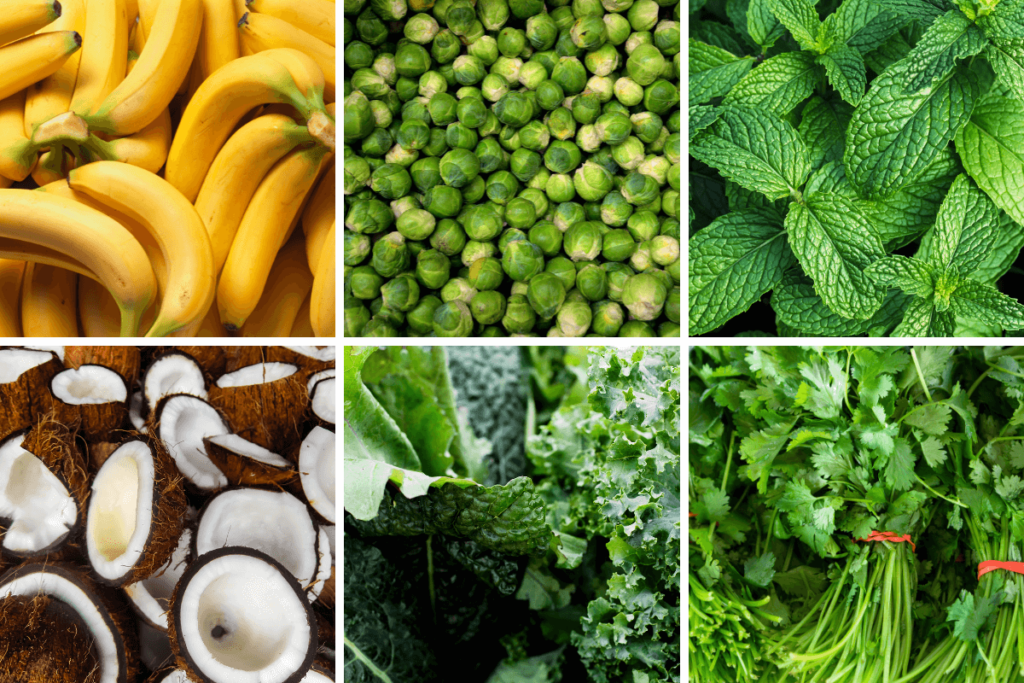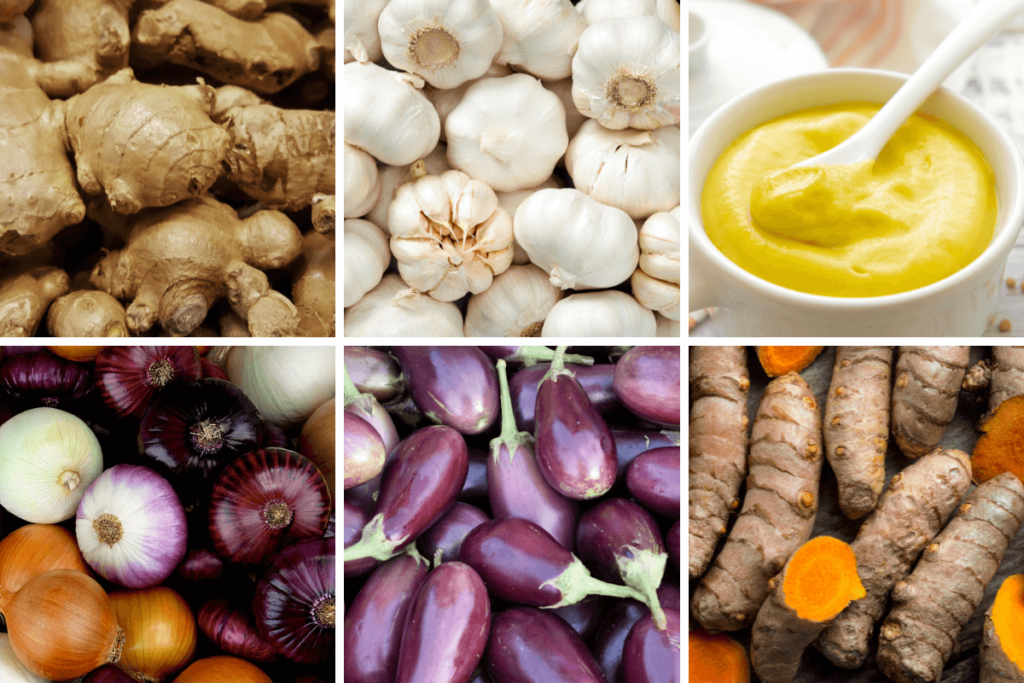You may not have thought about how food combinations can affect your digestive system but they do. The food combining guidelines of Ayurveda attempt to prevent bad food combinations so that your Agni (digestive fire) will remain ablaze to keep your digestive tract clean and clear of ama(toxins).
Let’s explore Ayurveda food combining suggestions to keep your Agni burning strong!
Ayurvedic Doshas And Your Diet
Ayurveda is the Science of Life, and sister science to yoga, with one of the most important aspects being the 3 Doshas.
Every person has each of these doshas in different amounts to create their unique constitution (Prakriti). When your current state of being is out of balance (Vikriti) you can bring it back into balance by increasing or decreasing these doshas.
What are these Doshas? Let’s review:
VATA
- Elements: Air and Space
- Light, cool, and dry
- Governs all movement
PITTA
- Elements: Fire and Water
- Hot, sharp, and oily
- Governs Digestion and Metabolism
Depending on your unique constitution (Prakriti) you may need to eat foods that align or balance your doshas. If you aren’t sure of your dominant dosha take my dosha quiz.
Each dosha has preferred foods and food that can create imbalance. Your dosha will determine what type of food is best for your constitution. Eating for your constitution results in improved health. Keep in mind as you select different foods and create certain combinations, some are better for the intestinal flora than others.
When it comes to food combining, there are general guidelines for a happy digestive tract. What are they?? Let me tell you!
Ayurvedic Food Combining
The goal of Ayurvedic cooking is to eat the best food for your digestive fire. You may have already discovered that certain food combinations, in your body, are not great for your overall health. Honor that direct experience above whatever you read below. You are the best judge of what you put in your stomach.
You know the saying “it’s all going to the same place anyway” is so true. Whatever you put in your mouth will end up together in your stomach. It’s almost like cooking everything you are eating in the same pot. Ayurveda has eating suggestions for each dosha but also some general guidelines for combining foods that apply to each dosha.
Incompatible food combinations cause your agni’s (digestive fire) post-digestive effect to increase ama (toxins). Avoiding incompatible foods/mismatched foods will help balanced digestion.
Before getting into specific food combinations, let’s look at cooling and warming food. Knowing the basics of cooling and warming food will give you a strong base on how to choose your meals and balance those doshas.
Cooling Foods In Ayurveda
Cooling foods can be eaten to help to calm inflammation, acidity, and heat in the body. They’re like the chill vibes for your internal system. Some examples of cooling foods include:
- Bananas: With their sweet taste and cooling nature, bananas encourage balanced digestion for all doshas and are easy to digest.
- Brussels Sprouts: These cruciferous vegetables have a mild, slightly nutty flavor and are known for their cooling effect, making them suitable for individuals with excess heat or Pitta imbalances.
- Mint: This herb is known for its cooling properties. Mint tea or adding fresh mint to your dishes can be a nice touch.
- Coconut: Coconut water and coconut flesh are considered cooling in Ayurveda. They’re also super versatile in cooking and beverages.
- Leafy Greens: Most raw leafy greens, like spinach and kale, are cooling. They’re packed with nutrients and can be incorporated into various dishes.
- Cilantro: This herb is not just for garnish; it’s cooling and adds a burst of flavor to many dishes.
When To Eat Cooling Foods
- Hot Summer Days: Cooling foods help beat the heat and keep you refreshed.
- Pitta Imbalances: To alleviate symptoms like heartburn, skin irritations, and excess heat in the body.
- After Intense Exercise: Cooling foods aid in bringing your internal temperature back to balance after a workout.
- Menopause: Especially helpful for managing hot flashes and internal heat associated with this phase.
- Stress or Irritability: Cooling foods can soothe your system when you’re feeling stressed or agitated.
- Pitta-Predominant Individuals: If you’re predominantly Pitta, incorporating more cooling foods helps maintain balance.
Warming Foods In Ayurveda
These foods and digestive spices are believed to provide warmth, stimulate digestion, and bring a sense of grounding. Here are some examples:
- Ginger: This spicy root is a superstar in heating up the body. Ginger tea, ginger-infused dishes, or even raw ginger can add a nice kick.
- Garlic: Known for its pungent flavor, garlic is considered heating. It’s not just a flavor enhancer but also has various health benefits.
- Mustard: Both seeds and the condiment itself, mustard is warming. Just a little can go a long way in adding depth to your meals.
- Onions: Onions have a heating effect, and they are a staple in many cuisines around the world. They add flavor and warmth to dishes.
- Nightshade family: Including tomatoes, bell peppers, and eggplants, Nightshades are very warm compared to other fruits.
- Turmeric: While turmeric is often associated with its anti-inflammatory properties, it also has a warming effect and will aid digestion. Golden milk, anyone?
When To Eat Heating Foods
- Cold Weather: Choosing warming food will provide warmth and comfort during chilly days.
- Vata or Kapha Imbalances: Heating food choices help counterbalance the cold and damp qualities associated with Vata and Kapha doshas.
- Lethargy or Low Energy: When you need an energy boost, incorporating heating foods can stimulate digestion and revitalize your system.
- Grounding: Food that heats can be beneficial for grounding, offering a sense of stability and warmth.
Example Ayurvedic Food Combinations
Now let’s talk about combining foods. You could spend many moons studying the dos and don’ts of Ayurvedic cooking. I’ll discuss some of the major things to avoid and tips for what food combining is best for digestion.
Cooked food combining
When you are food combining, it is best to avoid combining cooked foods and raw foods together. Imagine if you have cooked sweet potatoes and raw cauliflower in a salad. Your stomach will have difficulty digesting each food at the same time since the sweet potatoes are warm and soft, and the cauliflower is cold and hard. This will confuse the digestive fire, exactly what we are trying to avoid.
Food Combinations To Avoid
Here are some combinations you want to avoid:
Dairy products
CHEESE
Avoid eating cheese with:
- Fruits
- Beans
- Eggs
- Milk
- Yogurt
- Hot drinks
YOGURT
Yogurt should not be eaten with all of the above listed for cheese nor meat and fish.
MILK
Ayurvedic home remedies suggest that animal milk is enjoyed alone. More specifically the worst offenders to mix with milk include:
- Salt
- Cheese
- Fruits
- BANANAS
Bananas get their own category but fruits and milk are not a good ayurvedic combination. Especially sour fruit should be avoided with milk.
Considered one of the top incompatible food combinations, Milk and bananas will diminish the agni and should not be eaten together. The goal of Ayurvedic eating is always to be stoking, not putting it out. There is no concrete evidence to suggest that this combination causes indigestions so if you love bananas in your milkshakes or in your cereal and you don’t have any digestive discomfort – you do you!
Fruits
Food combining to avoid with fruits include:
- Vegetables
- Beans
- Grains
Fruits and especially melons should be eaten separately. Next time you are offered a fruit plate or salad if the goal is keeping your digestive fire happy, stick with one type of fruit.
If you are going to be eating fruit together, keep sweet fruit together, acidic fruits together, and sour fruits together. Mixing fruit types can give you an unfavorable post-digestive effect.
LEMONS
Bad food combinations with Lemons include:
- cucumber
- tomatoes
- milk
- yogurt
Food Combinations To Try
What are some food-combining tricks to keep your stomach and digestion happy?
ANIMAL PROTEINS
When making a meal with meat, pair it with light foods including non-starchy vegetables and leafy greens.
EGGS
Eggs are best paired with non-starchy vegetables and grains.
VEGETABLES
Vegetables are great for eating with:
- grains
- meat
- cheese
- beans
- spices
FAQ
For how long do I follow this diet?
Depending on your diet goals, you may choose to follow these suggestions for a brief period or you may want to upkeep these changes for a long time. Some factors to consider in your choice:
- Seasonal Changes: Ayurveda often recommends adjusting your diet according to the seasons. For example, you might emphasize cooling foods in the summer and warming foods in the winter. This adaptation allows you to align with the natural rhythms of the environment.
- Specific Health Goals: If you’re following an Ayurvedic diet to address specific health concerns or imbalances, you might continue until you see improvements. However, it’s essential to work with an Ayurvedic practitioner who can guide you based on your unique constitution and health conditions.
- Lifestyle Factors: Ayurveda is not just about diet; it encompasses lifestyle practices as well. You might incorporate Ayurvedic principles into your daily routine indefinitely for overall well-being, even if you make seasonal adjustments to your diet.
- Listen to Your Body: Ayurveda encourages paying attention to your body’s signals. If you feel that certain dietary adjustments are benefiting you, you may choose to maintain those practices. It’s a dynamic system that allows for flexibility based on individual needs.
What happens if I eat the wrong foods?
Poor food combining, according to Ayurveda, leads to poor digestion. Certain foods incompatible with your constitution or imbalances can lead to dosha aggravation, digestive issues, imbalance in mental qualities (Gunas), toxin formation (Ama), and disruptions in energy flow. You will notice that things just aren’t quite right inside.
Can Ayurveda help with weight management through food combinations?
Ayurveda considers an individual’s constitution (Prakriti) and current imbalance (Vikriti) when offering dietary advice. Proper food combining is believed to optimize digestion, which may contribute to weight management. For example, combining foods that balance your dosha and support your digestive fire can be a part of an Ayurvedic approach to maintaining a healthy weight.
Closing Thoughts
As you begin to experiment with Ayurvedic food play, know that your digestion may prefer other foods than your favorite tasty combination. I have just grazed the surface here but there are books and courses all about this topic! Listen and trust your body, it’ll guide you to what it needs.
Next Steps
- If you’re interested in practical kriya yoga as a way to improve your daily life and relationships, check out my Yoga for Self Mastery course.
- Order my Yoga Life book for a practical guide to creating balance in your life through yoga.
- Check out my YouTube channel and find some yoga classes that you can try out for yourself!
FREE Chakra Balancing Audio Track + Journaling Prompts

YOU MIGHT ALSO LIKE
- My Homemade Immunity Tea Recipe For Winter
- How To Do An Ayurvedic Panchakarma Cleanse At Home (Safely)
- Ayurveda Food Combining: The Key to Balanced Digestion
- How To Reduce Body Heat According To Ayurveda
- Types Of Agni In Ayurveda And How To Balance
- How To Balance Doshas And Step Into Your Powerful Self
- The Eight Branches Of Ayurveda: Guide To A Happy Life
- Yoga for Vata Dosha: Practice Poses and Tips
- Yoga for Pitta Dosha: Practice Poses and Tips
- Yoga for Kapha Dosha: Practice Poses and Tips
- Jal Neti Kriya: The Best Thing You Can Do To Clear Your Head Right Now
- My Exact Ayurveda Morning Routine For Yogis
- The 6 Stages of Disease in Ayurveda
- Discover Your Ayurvedic Constitution and Balance Your Mind, Body, and Spirit
- Understanding the Basic Principles of Ayurveda for Yogis
- 3 BEST Ayurveda Schools for a Holistic Ayurvedic Certification
- What Are Nadis? Your Guide to Energy Channels In Your Body.
- What Is An Ayurvedic Diet? Foods For Your Doshas
- A Day Around the Doshas: What I Learned When I Followed the Ayurvedic Clock
Learn how to do 11 of the most popular yoga poses correctly. Free video + PDF download.















